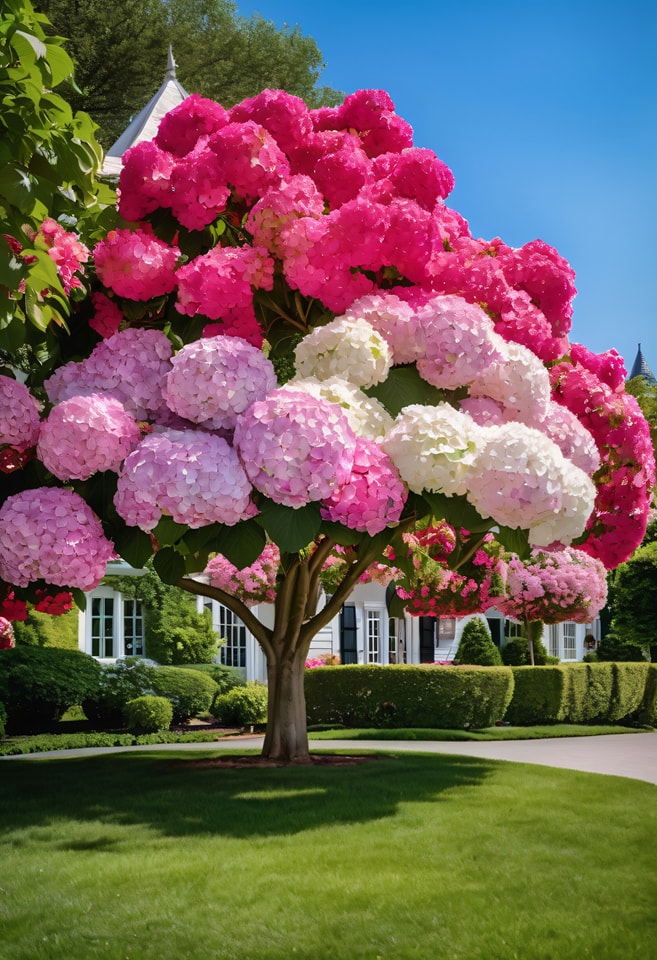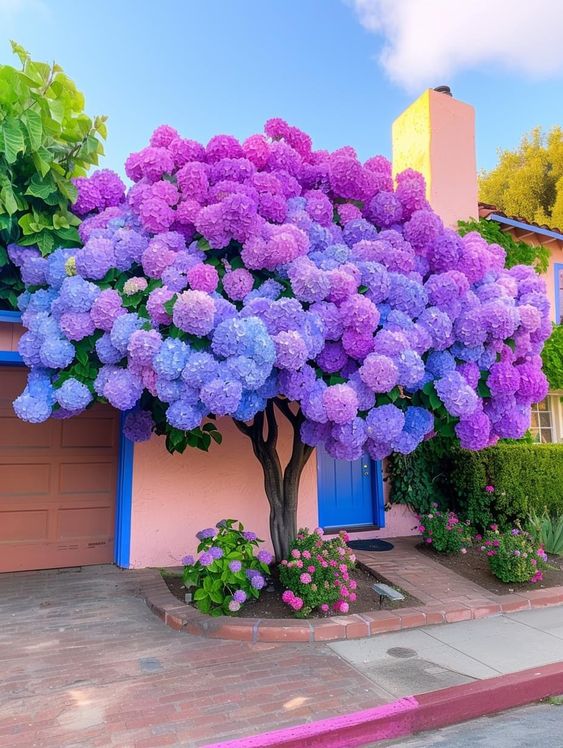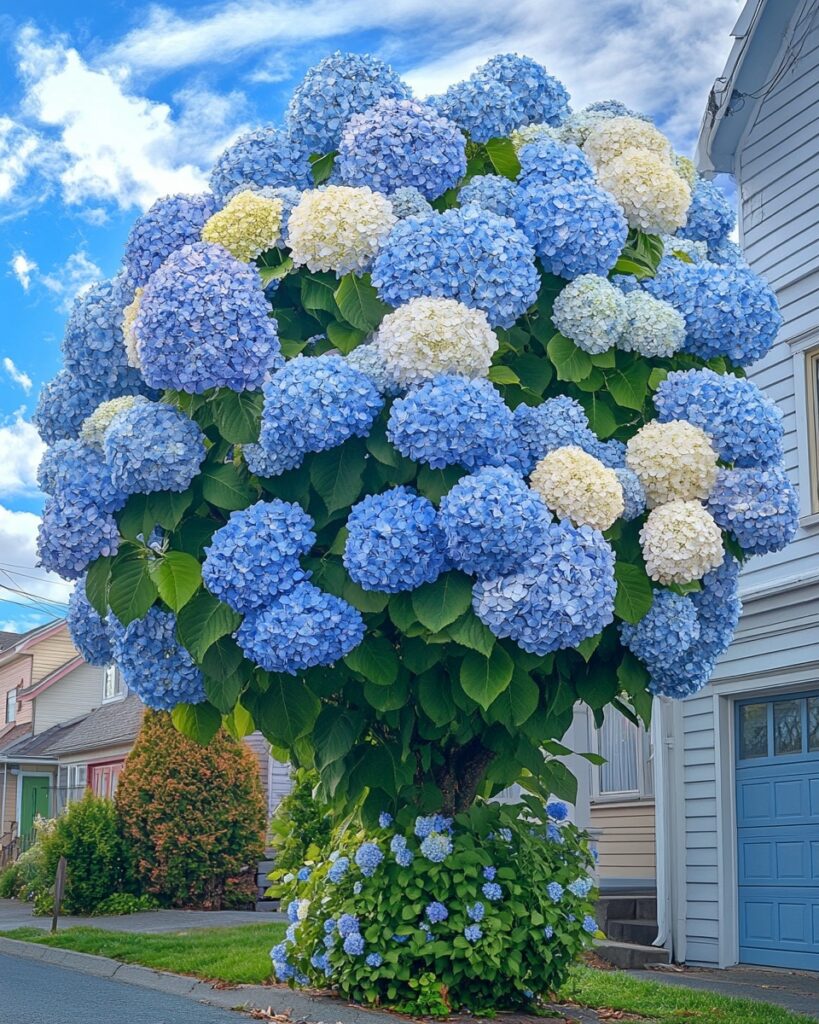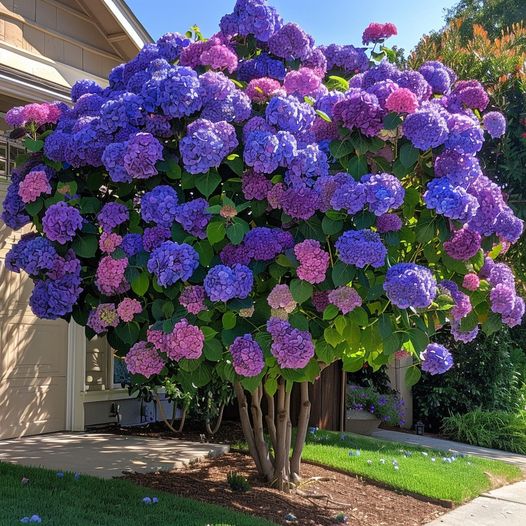The hydrangea, often hailed as the queen of flowering shrubs, is not just a plant; it’s a canvas for emotional expression and artistry in garden design. With hues ranging from serene blues to passionate pinks and crisp whites, each bloom seems to whisper tales of resilience and transformation. As we explore The Enchanting Hydrangea, we uncover an intricate tapestry woven with threads of biology, culture, and horticultural practices that enrich our understanding of this mesmerizing floral wonder. This journey begins with the cultivation and care instructions typically laid out in comprehensive guides. These resources provide both novice gardeners and experienced green thumbs with tactical insights into growing and nurturing hydrangeas, emphasizing their unique requirements in terms of soil, sunlight, and moisture—a vital triad to successful gardening.

Varieties and Their Charms: Exploring Diversity
One cannot appreciate the enchanting nature of hydrangeas without acknowledging the remarkable diversity among their species and cultivars. The plant comes adorned in numerous colors, shapes, and sizes that allow for personal expression in any landscape. For example, the well-loved Hydrangea macrophylla, or the bigleaf hydrangea, captivates with its massive flower clusters and adaptability to various climates, symbolizing hope and strength. Each variety offers something distinctive, making it possible to transform a garden layout simply by choosing different types.
Captivating Color Palettes
Hydrangeas come in a breathtaking array of colors, from the serene blue-hued blooms to the vibrant pink and lush white varieties. The ability of these plants to change their petal color based on soil pH is a fascinating phenomenon that adds an extra layer of enchantment to their cultivation. Gardeners can experiment with different soil amendments to achieve their desired color palette, transforming their outdoor spaces into personalized tapestries of floral hues.
Diverse Bloom Structures
Beyond the captivating color spectrum, hydrangeas also boast an impressive diversity of bloom structures. From the large, rounded clusters of the bigleaf hydrangea to the delicate, lace-cap formations of the mountain hydrangea, each variety offers a unique visual appeal that can be strategically incorporated into garden design. These various bloom shapes and sizes allow gardeners to create dynamic displays that cater to individual aesthetic preferences and complement the surrounding landscape.

Adaptability to Climate
The remarkable adaptability of hydrangeas to different climates is another factor that contributes to their widespread popularity. While some varieties thrive in temperate regions, others excel in more subtropical or even tropical environments. This versatility empowers gardeners to cultivate these enchanting flowers in a wide range of geographical locations, expanding the possibilities for incorporating them into personal outdoor sanctuaries.
Symbolism and Cultural Significance
Beyond their visual appeal, hydrangeas carry deep symbolic meanings across cultures. In some parts of the world, they symbolize gratitude, while in others, they represent heartfelt emotions, such as apology or understanding. The changing colors of the blooms—often dictated by soil pH—epitomize life’s transitory nature, reflecting how circumstances can drastically alter perception and experience. This multifaceted symbolism layers an additional dimension over their physical beauty, transforming them into living metaphors.
Gratitude and Appreciation
In several Asian cultures, hydrangeas are revered as symbols of gratitude and appreciation. The lush, abundant blooms are often gifted to convey heartfelt appreciation for someone’s kindness, support, or friendship. This tradition imbues the flowers with a profound significance, transcending their aesthetic appeal and becoming vessels for the expression of profound emotion.
Apology and Understanding
In other cultural contexts, hydrangeas have been associated with the expression of apology and understanding. The shifting hues of the blooms, particularly the transition from pink to blue, are seen as a metaphor for the fluidity of emotion and the ability to change one’s perspective. Gifting hydrangeas can convey a sincere desire to make amends or to convey a deeper understanding of another’s perspective.

Transience and Transformation
The ability of hydrangeas to change color in response to soil pH is a captivating phenomenon that has been imbued with symbolic meaning. The flowers’ capacity to transform and adapt to their environment reflects the transient nature of life, reminding us that our perceptions and experiences can be shaped by the circumstances we find ourselves in. This symbolism encourages us to embrace the impermanence of the human experience and to find beauty in the cyclical patterns of growth and change.
Pruning: Art Meets Science
The art of pruning hydrangeas is akin to being a sculptor chipping away at stone until beauty is revealed. Proper pruning techniques are essential for maintaining vibrant flowers and lush foliage, serving as a mechanism for rejuvenation in older plants. Understanding the right timing and technique based on the specific variety is crucial; for instance, some hydrangeas bloom on old wood while others flower on new growth. By employing the appropriate pruning strategies, each gardener becomes a co-creator in the lifecycle of these stunning blossoms, shaping not just plants but also the seasons of their gardens.
Timing is Everything
The timing of pruning hydrangeas is a critical factor in ensuring the health and vitality of the plants. Some varieties, such as the Hydrangea macrophylla, bloom on old wood, meaning that they produce flowers on the previous year’s growth. In these cases, pruning should be done immediately after the blooms have faded, typically in late summer or early fall. This allows the plant to develop new growth that will bear the following year’s flowers.
On the other hand, other hydrangea varieties, such as the Hydrangea paniculata, bloom on new growth. For these types, pruning can be done in late winter or early spring, before the plant begins to put forth new foliage and flower buds. By understanding the specific growth habits of each hydrangea variety, gardeners can time their pruning efforts to align with the plant’s natural lifecycle, maximizing the potential for robust blooms.
Technique Matters
The technique employed in pruning hydrangeas is equally important as the timing. Proper pruning involves carefully removing the spent flower heads, thinning out the interior of the plant to allow for better air circulation, and selectively trimming back the stems to encourage new growth. The goal is to maintain a balanced, well-shaped plant that can continue to thrive and produce stunning flowers year after year.

Gardeners must also be mindful of the specific pruning requirements for each hydrangea variety. Some types, such as the Hydrangea paniculata, respond well to more aggressive pruning, where up to one-third of the plant’s height can be removed. In contrast, the Hydrangea macrophylla may require a gentler touch, with only the removal of dead or damaged stems.
By mastering the art of pruning, gardeners become active collaborators in the lifecycle of their hydrangeas, shaping the plants’ growth and ensuring their continued vitality. This process of careful cultivation not only enhances the visual appeal of the garden but also fosters a deeper connection between the gardener and the natural world.
Rejuvenation and Renewal
Proper pruning techniques can also serve as a mechanism for rejuvenating older hydrangea plants. Over time, the stems and foliage of these shrubs can become dense and overgrown, resulting in diminished flower production. By selectively removing older, weaker stems and encouraging the growth of new, vigorous shoots, gardeners can breathe new life into their hydrangea plants, resetting the cycle of growth and bloom.
This process of rejuvenation is not only beneficial for the plants but also for the gardeners themselves. By engaging in the hands-on work of pruning and shaping their hydrangeas, gardeners can experience a sense of renewal and personal growth, mirroring the transformation occurring in their outdoor spaces.
Enhancing Blooms: Fostering Biodiversity
Interestingly, proper care and maintenance not only produce luscious blooms but also extend a metaphorical invitation for pollinators. A thriving hydrangea bush acts like a vibrant community event, attracting bees and butterflies. In fostering biodiversity, gardeners contribute to environmental sustainability. This interconnectedness emphasizes that cultivating beauty leads to fostering life, making every cut significant beyond aesthetics.
Attracting Pollinators
Hydrangeas, with their abundant and vibrant blooms, serve as a magnet for a wide variety of pollinators, including bees, butterflies, and even hummingbirds. By creating an environment that supports the health and well-being of these crucial creatures, gardeners can not only enjoy the visual delight of their hydrangea displays but also contribute to the broader ecological balance of their local habitats.
Through the strategic placement of hydrangeas within the garden, gardeners can establish corridors and oases that provide nectar, pollen, and shelter for pollinators. The diverse color palette and bloom structures of hydrangeas offer something for every pollinator, ensuring a steady stream of visitors throughout the growing season.
Environmental Sustainability
Beyond the intrinsic joy of attracting pollinators, the cultivation of thriving hydrangea plants also contributes to the broader pursuit of environmental sustainability. By fostering biodiversity and supporting the life cycles of bees, butterflies, and other vital species, gardeners play a vital role in maintaining the delicate balance of natural ecosystems.
This interconnectedness between the care and nurturing of hydrangeas and the preservation of ecological health serves as a powerful reminder that every gardening decision, from pruning to planting, has a ripple effect that extends far beyond the boundaries of the individual garden. By embracing this holistic perspective, gardeners can find profound meaning and purpose in their horticultural endeavors, transforming their outdoor spaces into sanctuaries that nourish both the beauty of the plants and the well-being of the broader natural world.
An Enchanted Experience: Guided Exploration
To delve deeper into the mesmerizing realm of hydrangeas, there are a plethora of resources available including comprehensive eBooks and online guides that illuminate planting techniques and care specifics. They serve as roadmaps for setting up your very own hydrangea haven, inviting readers to reflect on how cultivating these beautiful plants mirrors personal landscaping—transforming our surroundings can lead to profound inner change.
Comprehensive Resources
From in-depth eBooks to informative online guides, the wealth of resources available on hydrangea cultivation and care is truly remarkable. These comprehensive materials delve into the nuances of soil preparation, sun exposure, watering regimes, and pruning techniques, empowering gardeners of all skill levels to successfully grow and nurture these enchanting flowers.
By immersing themselves in these resources, readers can gain a deeper understanding of the specific needs and requirements of various hydrangea varieties, allowing them to make informed decisions when selecting and placing the plants within their gardens. The practical, step-by-step guidance provided in these guides can be particularly valuable for novice gardeners, serving as a trusted roadmap for their hydrangea-growing journey.
Personalized Landscaping
Beyond the practical cultivation advice, these resources also invite readers to explore the deeper connections between hydrangea gardening and personal growth. The act of transforming one’s outdoor space through the deliberate selection and placement of hydrangeas can be a profoundly reflective experience, mirroring the process of internal transformation and self-discovery.
Just as the vibrant blooms and changing colors of hydrangeas evoke a range of emotions and symbolism, the process of curating a personalized hydrangea-centric garden can serve as a metaphor for the ways in which we shape and nurture our own lives. By aligning the aesthetic and symbolic elements of these enchanting flowers with our individual preferences and aspirations, we can create outdoor sanctuaries that not only delight the senses but also nourish the soul.
Creating Your Oasis
Consider imagining your ideal space filled with flourishing hydrangeas, each contributing their unique flair to a personalized outdoor sanctuary. This involves not only selecting the right varieties but also thoughtfully planning where to place them based on sunlight exposure, water drainage, and complementary flora, thus allowing each bloom to shine in its full glory—like adding characters to an elaborate narrative.
By exploring aspects of color, cultural significance, care techniques, and the enchanting experiences tied to hydrangeas, we unveil the hidden wonders behind these seemingly simple blooms. They serve as a rich reminder that nature’s most alluring forms often encapsulate much more than mere aesthetics—orchestrating a dance between art, science, and sentiment in every petal.
Conclusion
The journey through the enchanting realm of hydrangeas has revealed a multifaceted world that transcends the bounds of mere horticulture. These captivating plants serve as a canvas for emotional expression, a tapestry of cultural symbolism, and a testament to the intricate balance between art and science in gardening. By delving into the diverse varieties, pruning techniques, and the role of hydrangeas in fostering biodiversity, we have uncovered a profound appreciation for the depth and complexity that lies within these seemingly simple blooms.
As we continue to explore and cultivate our own hydrangea havens, we are invited to reflect on the ways in which these plants mirror the ebb and flow of our own lives. The ability to shape and nurture these stunning flowers, to witness their transformation through the seasons, and to invite pollinators into our gardens, serves as a profound metaphor for the power of personal growth, environmental stewardship, and the intertwined nature of beauty and sustainability.
The Enchanting Hydrangea has intrigued and captivated us, inviting us to step into a world where horticulture, culture, and emotion converge, creating a symphony of wonder and inspiration. As we step forward, let us embrace the lessons of these enchanting blooms, using them as a guidepost for our own personal journeys and the collective pursuit of a more harmonious, vibrant, and sustainable future.




